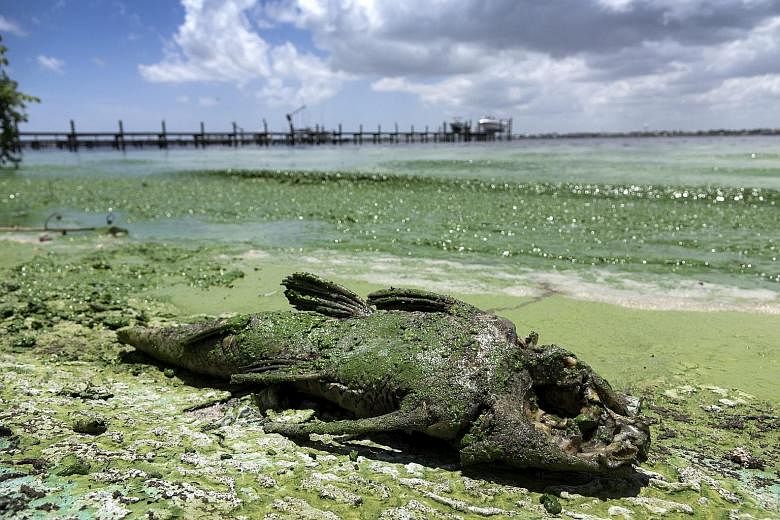ORLANDO (Florida) • The stench of decaying algae began rising from coastal waterways in south-eastern Florida early this month, shutting down businesses and beaches during a critical tourism season.
Officials arrived, surveyed the toxic muck and declared states of emergency in four counties. Residents shook their heads, then their fists, organising rallies and haranguing local officials.
In truth, there was little they could do: The disaster that engulfed the St Lucie River and its estuary had been building for weeks.
In May, a 53 sq km algal bloom crept over Lake Okeechobee, the vast headwaters of the Everglades. After an unseasonably wet winter, the Army Corps of Engineers had to discharge water from the lake to lower water levels, flushing the ooze along channels to the east and west until it coagulated along the shores of the famed Treasure Coast.
The mess in Florida is only the latest in a string of algal blooms that some experts believe will increase in frequency and in severity.
An immense plume of blue-green algae last September covered a 1,023km stretch of the Ohio River. A month earlier, the city of Toledo, Ohio, warned more than 400,000 residents to avoid drinking tap water after toxic algae spread over an intake in Lake Erie. (The Lake Erie bloom is now an annual event.)
-
Algae: Types, causes and effects
-
Algae is a catchall term referring to a variety of aquatic organisms that generally rely on photosynthesis for energy and reproduction.
So while blue-green algae are cyanobacteria, a so-called red tide is composed of tiny dinoflagellates. Seaweed is a sophisticated alga, as is kelp.
Algal blooms can turn water bioluminescent. The glow is caused by dinoflagellates that produce a hazardous neurotoxin. Many algal species produce similar toxins. Cyanobacteria produce microcystins, for example, which can affect the liver and be deadly to humans.
When vast blooms occur, these poisons may spread through the environment and up the food chain to fish and animals that feed on them.
Algal blooms are a natural occurrence, but are being intensified by human activity. Chief among the culprits are run-off from farms, feedlots and municipal sewer systems.
NEW YORK TIMES
Almost exactly a year before the Florida bloom, another spanning 12,070 sq km washed ashore in Qingdao, China, a popular beach destination. Government officials called in hundreds of boats and bulldozers to remove it. The green blob appeared again earlier this month.
The largest and most dangerous algal bloom ever recorded, which ranged from Central California to British Columbia in Canada, produced high levels of a toxin that last year closed crab and clam fisheries along the West Coast of the US.
Such algal blooms are a natural occurrence. According to Dr William Cochlan, a senior research scientist at San Francisco State University, Native Americans had known for centuries to avoid bioluminescent water.
But although they occur naturally, algal blooms are being intensified by human activity in ways that scientists are still trying to quantify. Chief among the culprits: run-off from farms, feedlots and municipal sewer systems.
"The bloom itself is the visual manifestation of nutrient over-enrichment in lakes," said Dr Tim Davis, an ecologist at the National Oceanic and Atmospheric Agency's (NOAA's) Great Lakes Environmental Research Laboratory in Ann Arbor, Michigan. "In freshwater systems, both nitrogen and phosphorus are the main nutrients."
In Florida and the Great Lakes, nitrogen and phosphorus come mainly from fertilisers used in large farming operations, along with septic tanks, manure and storm water.
Last year's vast algal bloom in the Pacific was fed in part by El Nino, the mass of warm water that forms periodically off the West Coast. But longer-term climate change may be playing a role, some experts say.
Warming atmospheric temperatures and wetter weather in some parts of the United States increase the nutrient-laden run-off into streams, lakes and the ocean. And as ice melts in the Arctic, sea temperatures are rising and more sunlight is filtering into the ocean.
"Some of the features of climate change, such as warmer ocean temperatures and increased light availability through the loss of sea ice in the Arctic, are making conditions more favourable for phytoplankton growth - toxic and non-toxic algae - in more regions and farther north," said Dr Kathi Lefebvre of the NOAA's Northwest Fisheries Science Centre in Seattle.
"It is likely that toxic blooms will continue to increase and expand as these features of climate change continue," the biologist added.
Dr Davis said he believed climate change was working against efforts to prevent algal blooms.
"I certainly believe as a scientist that climate change will influence the size and intensity of these blooms," he said. "If nothing changes - the increase of rainfall, the increase nutrient loads, warmer water - all of this could lead to larger blooms that last longer and are more toxic."
NEW YORK TIMES

